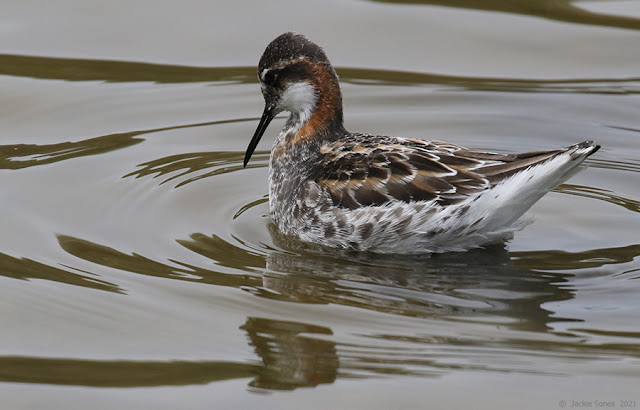Shorebird week continues! I recently came across several Red-necked Phalaropes (Phalaropus lobatus). They were busy feeding, so I just sat quietly and watched for a few minutes. Luckily I had my camera and larger lens at the time. Here are a couple of photos of the brighter female:
And several of a browner/grayer male:
I've heard of a few other phalarope reports recently —
they're migrating through this region on their way to breeding areas in the Arctic. Although they're usually farther offshore, with the windy conditions of today/tomorrow, more might be pushed towards the coast. Sometimes phalaropes show up in the marsh/entrance pond at Doran Beach, or near the mouth of Salmon Creek, so if you're in those areas, keep your eyes open!







4 comments:
Really fabulous photos...the last one took my breath away. It feels so personal!
I'm wondering, seeing your recent posts of "red" birds, is the arctic vegetation, during this breeding season, contain a lot of "red"?
Hi Jackie, your knot photos gave me great pleasure, we hardly ever see them in full summer plumage here. Also to see the dowitchers -- you pointed them out to me when we went birding back in 2013, I had no idea they were so snipe-like. As for your red-necked phalaropes, these are really gorgeous shots. Thank you so much for sending your world to this side of the globe at this dark time. Best wishes, Paddy
Hi, Sue!
So I asked a friend who spent time studying shorebirds in the Arctic. He said, "Yes, there is quite a bit of orange to red in the tundra vegetation. Early in the season it's pretty tan-grey in the grassier-sedgier habitats, but even those can have some orange in old blades. In those and most other short tundra habitats there may be old dwarf willow leaves, moss and lichen reproductive stalks...In the coastal marshes, orange-red is the dominant color, from a Puccinellia grass species and a Carex sedge, and perhaps an alga on the mud." He also mentioned that doing an Internet search for images of arctic shorebird nests or arctic tundra vegetation would probably produce some images with that orange-red hue mixed in with the tans and greens.
:) Jackie
Paddy! Great to hear from you, as always! I'm so glad the shorebird pictures made their way to you across the miles. I don't know about you, but during troubling times, I find myself turning outward even more than usual. I'm so grateful for the wonder and beauty often just a short walk away. Thank you so much for writing and take care, :) Jackie
Post a Comment